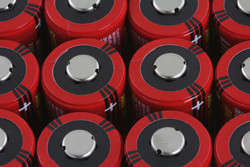Charging towards a Li-air battery solution
A Li metal anode instead of graphite and the use of oxygen (O2) from the air as a cathode promises up to 10 times greater energy density. However, O2 reduction following reaction with Li-ions leads to deposition of a solid product within cathode porosities and to cathode clogging. Scientists addressed this issue with a radical approach not yet tried. EU funding of the LABOHR (Lithium-air batteries with split oxygen harvesting and redox processes) project supported investigations of Li-air battery operation in the flooded (two-phase) configuration with a dual role for the electrolyte, as charge carrier and O2 carrier. Conventional metal-air batteries, as well as fuel cells, rely on three-phase contact points within the cathode. The contacts ensure electron transport, hydrogen transport and O2 influx. However, in the case of Li-air, this operating configuration changes the porosity and hydrophobicity of the cathode because of the formation of the reduction products at the three-phase contact points. In groundbreaking studies, the team investigated a two-phase contact-point electrode configuration (a flooded configuration). The electrolyte or charge carrier is also used as the O2 carrier to harvest O2 from ambient air through an external O2 harvesting device. The LABOHR concept employs environmentally benign ionic liquid electrolytes and nano-structured electrodes that harvest dry O2 from the air. Scientists prepared and tested anode and cathode materials, developed the O2 harvesting concept, and prepared and integrated into the electrode systems numerous ionic liquids as well as solid polymer electrolytes. Fundamental studies provided physicochemical parameters for the model of a full Li-air battery pack. Although the practical implementation of Li-air batteries is not expected for another decade or two, LABOHR has made a major contribution to the development effort. Studies confirmed the importance of using ionic liquid-based electrolyte solutions to address solvent reactivity and volatility issues, and highlighted the problems of operating the Li-air battery in three-phase configuration. The concept of soluble redox ‘shuttle’ also opened a new possible path toward practical Li/O2 battery. In the meantime, the studies of electrolytes and electrode materials are likely to find short-term application in the Li-ion battery field.







